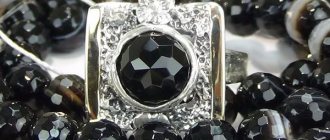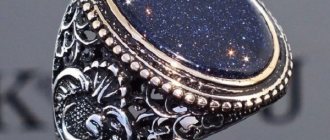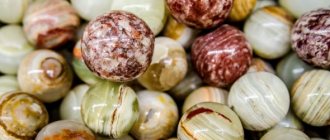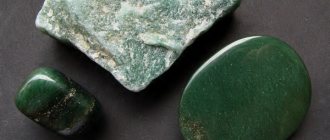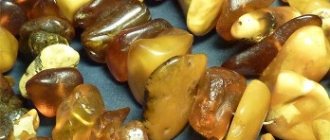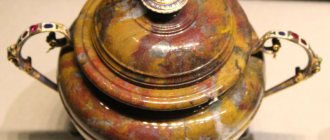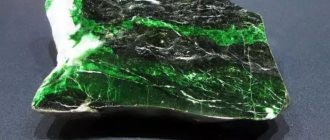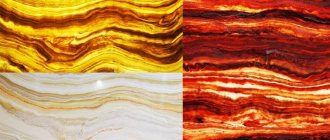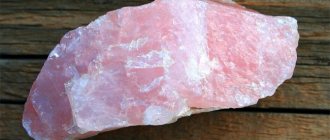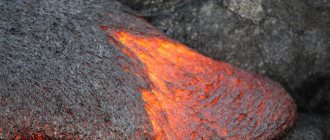History of discovery
In 1786, Abraham Gottlob Werner, a teacher at the Freiberg Mining Academy, began to classify the minerals known at that time. The matter did not proceed quickly, since it was accompanied by research into samples stored at the academy, but without scientific definitions or established names.
Augite, hitherto nameless except for popular nicknames, came to Werner’s laboratory table only in 1792. After conducting a series of experiments and carefully examining the specimen under a magnifying glass, the scientist ordered:
- for its bright shine, contrasting with the dull appearance of the sample, give the mineral the name “augite”, which means “sparkling”;
- assign augite to the silicon order and make it the ancestor of a whole genus called augites.
Varieties
Augite is conventionally divided according to the content of Fe and Mg (in at.%) into the following varieties:
- Magnesian augite - magnesian augite Mg 45-70, Fe 0-10.
- Augite (actually) - augite Mg 30-60, Fe 10-40.
- Ferroaugite - ferroaugite Mg 10-40, Fe 30-60.
- Ferrohedenbergite - ferrohedenbergite Mg 0-10, Fe 45-70.
* Fe = Fez+, Fe3+, Mn, Ti.
The names magnesian augite and ferroaugite are given based on the contents of Mg and Fe, which are greater than in augite itself; ferrogedenbergite - due to a higher iron content than hedenbergite.
According to the Ca content, these varieties include calcium-poor augite and ferroaugite (Ca0.36-0.6) and calcium-rich magnesian augite, augite proper, ferroaugite, ferrogedenbergite (CaO0.80-0.84 in the formula unit).
Since the boundaries between these varieties are determined only by chemical composition, and other properties are not clearly expressed, they are not described separately.
The literature also describes poor and aluminum-rich augites, sodium, titanium, chromium augites - ferrogedenbergites; all of them do not even have conventional boundaries with the main varieties.
Augite
mCa(Mg, Fe) (SiO3)2 *n(Al, Fe)2O3. Monoclinic.
Ng = 1.713—1.737; Nm = 1.707—1.717; Np = 1.688—1.733; Ng—Np = 0.025.
Optically positive. 2V = 58-62°; r > v, in the very rich
iron r < v. b = Nm; c: Ng from +45 to -54°. Pl. O. O. (010).
It is an isomorphic mixture of CaMgSi2O6, MgAl2SiO6, FeAl2SiO6, MgFe2SiO6, often with an admixture of TiO2, sometimes up to several percent.
Chemical composition of augite from gabbro-corite rocks (average of 30 analyzes in%): SiO2 50.39; TiO2 0.51; Al2O3 3.95; Fe2O3 1.73; FeO 9.20; MnO 0.19; MgO 15.15; CaO 17.82; Na2O 0.18; K2O 0.09; HaO 0.82; beat weight - 3.28. The numbers are close to the composition of augite from basalts and diabases.
Ud. weight 3.2-3.6. Augite forms short-columnar crystals with quadrangular and octagonal cross-sections. Its crystals are sometimes beautifully formed. It is also often found in the form of irregular grains. The cleavage is perfect in a prism (110) with an angle of 87°.
Twins no (100) and by (001), sometimes simultaneously according to both laws. The color of augite is most often black.
In thin sections, augite is usually slightly brownish or brownish; in the presence of titanium, it acquires a more or less dark brownish color with a violet tint.
In basaltic augites, mainly in titanium-augites of alkaline rocks and basalts, an hourglass structure is often visible in connection with the zonal structure; In different zones, different interference colors, dispersion, and extinction angles are observed.
Pleochroism is usually weak, which distinguishes augite from hornblende; it is best manifested on planes (100); pleochroism is more sharply observed in augites enriched with iron or titanium: With small amounts of sodium it acquires a greenish color due to the admixture of aegirine molecules.
Sharp relief and shagreen surface. Interference coloring in normal sections up to the second order. The plane of the optical axes (010).
In transverse sections, the extinction is symmetrical with respect to the cleavage cracks; in longitudinal sections, perpendicular to (010), the extinction is direct. On the (010) planes, a kind of concentric extinction is sometimes observed with the formation of an “hourglass” figure.
Dialag is a variety of diopside and augite, poor in Al2O3, having a fine separation according to (100), partly according to (101). Omphacite is a green variety of augite, usually containing 4-9% Al2O3; found in eclogites. These varieties are almost indistinguishable in optical properties from augites. Typically, diopsides do not have bisector dispersion.
Titan-augite is distinguished by a brownish and violet tint of color. It is characteristic that titanium-augites are often surrounded by a shell of aegirine and aegirine-augite, which differ sharply from titanium-augite in greenish or green color. In titanium-augite, the hourglass structure is often particularly pronounced and the oblique dispersion of the bisectors at r > v is often so pronounced that extinction does not occur in sections parallel to (010). In general, its extinction angle is c:Ng = 40-50°. Characteristic of basic alkaline rocks, both extrusive and intrusive; often together with nepheline.
When augites are transformed, chlorite is obtained, in other cases serpentine or fibrous green amphibole (uralite);
the latter process is called uralitization; Simultaneously with uralitization, a change in the chemical composition of pyroxene occurs. Along with feldspars, augites play an important role in rocks, forming the main components of a number of igneous rocks, both deep-seated (some granites, gabbros, pyroxenites, etc.) and erupted (basalts, andesites, etc.). Diopside, like hedenbergite, is often present in both contact rocks and igneous (extrusive and deep-seated) rocks. Dialag is especially common in coarse-grained igneous rocks, for example, gabbro, norites, etc., and is absent in lavas. Monoclinic pyroxene, usually light-colored (malacolite), is part of various crystalline schists (amphibolites, gneisses, eclogites, etc.); still little studied. Enstatite and magnesium diopsides are present in some CaO-poor diabases and basalts. Augites and diopsides differ from similar orthorhombic pyroxenes in their extinction, greater strength of birefringence, and from hypersthene, in addition, in the absence of sharp pleochroism. Diallate is similar to bronzite and hypersthene separately in (100), sometimes with a fibrous composition and brownish lamellar inclusions; differs in extinction, strength of birefringence and position of the plane of the optical axes, one of which is almost parallel to the vertical axis c. They differ from epidote and olivine in their properties in converging light, and from epidote, in addition, in color.
Physicochemical characteristics
The mineral is a multicomponent silicate. Depending on which element predominates, augites are distinguished, where there is more magnesium, where there is more iron, and where they are equal. In addition to these two metals, chromium, calcium, aluminum, titanium, sodium, and aluminum are found to a greater or lesser extent in the composition of augites.
| Property | Description |
| Formula | (Ca,Na)(Mg,Fe,Al,Ti)(Si,Al)2O6 |
| Hardness | 5 — 6,5 |
| Density | 3.2—3.6 g/cm³ |
| singonia | Monoclinic |
| Kink | The mineral is elastic, flexible, splits into leaves |
| Cleavage | Average by {110} |
| Shine | Glass |
| Transparency | Translucent or opaque |
| Color | Black and greenish |
Crystals in the form of columns or needles with an octagonal cross-section. Coming together, they form beautiful clusters - druses. Found in volcanic rocks: basalts, andesites.
The stone looks inexpressive. Specimens with a reddish, yellow, or violet tint are valued, but usually the crystals are brown-green and greenish-black. When melted, it turns into glass.
The coloring is uneven, because of this landscape motifs appear - the outlines of a river, a tree, a flower, a rock.
When split, the stone forms perfectly smooth surfaces due to the perfect cleavage of the layers.
Description
Augite is predominantly formed as part of other rocks. As a rule, this is andesite, basalt or diabase. If we consider the stone from the point of view of attractiveness, then it cannot be said that it has perfect beauty. However, the properties of the mineral include other characteristics that still allow it to be used in jewelry:
- the presence of pleochroism is an optical property that is expressed in a change in shade when a ray of light passes through the stone;
- beautiful shade after processing, which varies from black to dark green;
- acid resistant;
- despite the tint, it is not radioactive;
- Easily polished and faceted.
At the same time, the luster of the mineral can be different, depending on the conditions of formation - glassy, resinous, greasy.
Main gem deposits:
- Czech Republic;
- Russia;
- Ukraine;
- Italy;
- Norway;
- Germany;
- Mexico.
Origin and location
Most often a rock-forming mineral of various igneous rocks. It is found primarily in basic volcanic rocks, including basalts, partly in andesites, phonolites and volcanic ashes. On our planet, augite is found everywhere - in almost all rocks of igneous origin. Augite is also found in kimberlite pipes.
This is interesting!
Augite is a legitimate celestial. It has been reliably established that meteorites arriving on Earth often contain one or more varieties of augite. Augite has also been found in lunar soil and regolith.
Place of Birth
Pyroxene deposits are not found at great depths. That is why experts believe that the minerals are not of volcanic origin. However, augite may have a magmatic nature despite everything. Augite forms granular masses. Crystals grow in rare cases. The stones are similar in appearance to prisms. Most stones have an elongated shape, and augite has short prisms.
Augite is a fairly common breed, so mining takes place in Russia on Lake Baikal, in the Irkutsk region and in Korshunovsky. Stone deposits can also be found in Yakutia and the Krasnoyarsk Territory, near Taimyr, in Transbaikalia, and the Khabarovsk Territory. It should be noted that this mineral can be found on almost all continents.
Healing properties of the stone
Healing stone is important for humans. Traditional healers use it to treat eye diseases, heart and vascular diseases. By the way, black-green augite is often used as a love spell (powder from the mineral is added to drinks). It is believed that mental disorders are also susceptible to the influence of the dark gem.
It is noticed that the patient interacting with the stone improves the condition caused by the disease of the cerebral cortex. The mineral calms and balances, relieves depression, and puts you in an optimistic mood.
Magical properties of augite
Oddly enough, the mineral symbolizes joy and pleasure. It is believed to attract success and wealth to the owner. It is recommended to have it as a talisman for caring people who boldly walk through life and have an active life position. The “plant” frame enhances the spiritual power of the stone.
The magic stone augite distracts the owner from harsh actions, helps to properly distribute time, and build a life rhythm.
Products, like raw minerals, help to think rationally and balance the positive and negative in a person. This, in turn, improves the quality of life and actually leads to success in business. The owner of the gem will certainly feel changes for the better.
The color of the mineral is “responsible” for changes in its own way. Brown will lift your spirits and relieve fear and depression. Green will help avoid conflict or neutralize its consequences. Black activates creativity.
Properties
The stone does not have bright and expressive colors; most often it has muted dark green tones. Specimens with reddish, purple, and yellow hues are most valued, as they are rare. If the mineral is split, its parts will have a smooth surface due to the cleavage of the layers. When heated strongly, it turns into glass, and during processing it crumbles, as it has a fragile structure. Despite this, the gem practically does not deteriorate when interacting with acids.
In Italy, this mineral is one of the main symbols, so tourists often bring home souvenirs with it.
Augite is also known for its medicinal properties . These include the following:
- beneficial effects on the psyche and emotional state;
- help with eye diseases;
- benefits for blood vessels and heart;
- treatment of anxiety and depression;
- improving memory and attention.
You can also highlight magical properties :
- attracts financial wealth;
- helps to think positively and remove negative attitudes;
- relieves sad thoughts and melancholy;
- protects against rash actions and spontaneous decisions;
- attracts good luck.
Who is it suitable for?
As many people know, stones should be selected according to their zodiac sign . The great advantage of augite is that it can be worn by all people, but it will affect each of them differently. For example:
- Aries will become more collected, learn to take care of their health;
- Cancers will always be protected, their health will become stronger;
- Libra will learn to accept the help of people around them, which is usually given to them with great difficulty;
- Pisces will be able to realize their creative potential;
- Capricorns will improve relationships with family and friends;
- Scorpios will strengthen the nervous system and stop worrying about trifles;
- Virgos will increase their attractiveness in the eyes of fans;
- Taurus will be protected from the negative energy of envious people;
- Gemini will be able to gain self-confidence and cope with mood swings;
- Leos will be able to cope with problems and obstacles along the way;
- Sagittarius will be successful in spiritual development;
- Aquarius will be accompanied by luck and fortune, and their health will always be under reliable protection.
Areas of application of augite
Augite is an affordable ornamental material and is often used to create jewelry and inexpensive crafts. Transparent minerals look great in earrings and rings, pendants and bracelets. The setting for the stone can be made of silver or other metals.
Unusual crystals are mined on many continents and can be found in the collections of famous collectors. The cut of augite gives it even more splendor, so it can be used for interior decoration. The mineral is also used in other industries.
The jewelry industry also uses augite to create beautiful pieces. Despite the fact that the mineral is quite fragile by nature, jewelers are able to create real works of art from it. Coloring landscapes of gems allows the mineral to be used in famous brands. Usually the crystals are only partially translucent, but during cutting and polishing the effect becomes stronger.
Augite is not a stone of noble origin; it belongs to the group of ornamental stones. The stone is often combined with jewelry alloys based on copper. What shape a stone is cut into is very important in Italy and other countries. There you can find products made of augite in platinum, gold and silver.
Application
Augite is not classified as a precious or semi-precious stone; it is an ornamental material. Faceted stone is used in interior decoration, but you need to be careful with it because of its fragility.
Jewelry is not in high demand, although more or less transparent minerals look presentable in earrings, pendants, brooches, rings, and bracelets. The fragility of the material is balanced by its beauty after processing, when the translucency effect is enhanced.
The frame is made of silver, cupronickel, copper alloys. There are jewelry with stones, set in gold, silver, and platinum. This is typical for Italy, one of whose symbols has long been augite, and where there are a lot of souvenirs with this gem.
Due to the fragility of the mineral, facet cutting is used very rarely. Mostly dark green cabochons called “Chinese onyx” are used for crafts and jewelry. In Russia and France, unusual crystals are found, nicknamed “Auvergne pyroxenes.” Collectors are hunting for them.
Stone bracelet
Augite is not difficult to synthesize, for example, from basalt and other rocks. You can distinguish a gem from a fake by its appearance: augite will be more modest and less noticeable. However, the low cost of an artificial craft, like a real crystal, makes imitation economically unfeasible.
Also read: Amethyst - an ancient protector for a young family
Price, storage, care
Since there is no shortage of this mineral in nature, the products are inexpensive. If they ask for a high price, they justify it by saying that the stone is natural. Collectors can buy a piece at an inflated price if it is unique. A crystal measuring 5x8 centimeters can cost either 500 or 5 thousand rubles.
Exclusive products are valued for their artistic processing. An oval brooch or ring without a frame can be found for 700-1000 rubles. A bracelet made of beads without artistic processing - for the same amount.
Important!
It is advisable to store jewelry in a separate box so that different stones do not touch. It is not difficult to care for: regularly, but not often, polish with suede or thin felt.
Price of products
Most often, costume jewelry is made from augite, using inexpensive metals and alloys for the setting. The stone is affordable and can be purchased at the following prices:
- $6-8 – for a crystal measuring 8 x 5 cm;
- $12 – for a bracelet made of uncut oval beads;
- $20 – for a bracelet in which augite is combined with chiastolite, hematite and larvikite;
- $25 – for beads with the same stones as the bracelet.
The cost of souvenirs in the form of boxes and balls can be very high. It depends not only on the size of the product and the deposit of the stone, but also on the quality of the artistic decoration.
The influence of Augite on the signs of the Zodiac
Augite symbolizes radiance, you should understand who this mineral is not suitable for and is suitable for, whether it can be used as a talisman. Since ancient times, Augite has symbolized pleasure and joy and contributed to the prosperity and success of its owner. It is recommended to be worn by people with an active lifestyle so that they can achieve success in all endeavors.
The mineral helps cure diseases associated with vision; it is also often used as an auxiliary substance for love spells. It is necessary to understand what properties the stone has and what effect it has on the signs of the Zodiac.
- Aries. The aura of the stone contributes to the organization of Aries, helps not to be late, and to be on time everywhere. The mineral carefully protects the health of this sign from diseases.
- Calf. Those born under this sign are quite strong in their profession, they love to surround themselves with reliable individuals, and enjoy their work. Augite protects against negative influences from outside.
- Twins. With the help of Augite, those born under this sign gain confidence in their own abilities, calm down, and the person’s emotional state returns to normal.
- Cancer. Augite has miraculous properties; in Cancers, it helps improve the functioning of blood vessels, normalizes vision, and normalizes the physical condition of the body.
- A lion. Augite helps this sign cope with various changes in life and does not allow one to give up.
- Virgo. This sign will be very attractive to the opposite sex if worn on the right hand. If Virgo already has a soulmate, then the relationship can move to a new level.
- Scales. With the help of a mineral, this sign will be able to accomplish something very memorable and help others.
- Scorpion. Augite will make Scorpio a calmer person.
- Sagittarius. Zodiac signs belonging to the element of fire will be able to develop in the spiritual sphere with the help of Augite. In creativity, the stone will give inspiration.
- Capricorn. Augite will help strengthen relationships with others and eliminate scandals.
- Aquarius. The sign is perfectly compatible with the stone; he will experience only positive emotions from wearing it.
- Fish. Those born under this sign will feel new abilities for creativity. The stone will help them find themselves in a new role.
5 / 5 ( 11 votes)
Compatibility of the stone with zodiac signs
When figuring out who the stone is suitable for and for whom it is useless, you should remember that the astrological properties of the universal mineral affect representatives of the zodiac signs differently:
- In Aries, it develops organization, punctuality, and protects health.
- Taurus protects from the evil eye.
- With the help of Augite, Geminis become more confident in their abilities, less emotional and hot-tempered.
- For Cancers, the gem acts as a personal doctor. Improves the functioning of the heart and blood vessels, has a beneficial effect on vision.
- Helps Leos cope with problems, supports.
- Virgos feel that with an augite amulet they are more attractive to the opposite sex.
- It becomes easier for Libra to help others.
- Scorpios, having become the owners of augite jewelry, normalize the nervous system.
- Sagittarius will feel a craving for spiritual life and will succeed in creativity.
- Capricorn will strengthen relationships with relatives and colleagues.
- The mineral's compatibility with Aquarius is ideal.
- In Pisces, the stone will develop creative abilities.
Also read: Allanite is a storehouse of rare elements
From the point of view of esotericists, there is not a single zodiac sign for which Augite is contraindicated. The magical properties are not affected by the name, outfit, or hair color. Everyone can use the gem for increased material well-being, good luck, and new achievements. You can wear it on any finger.
Is this stone right for you?


